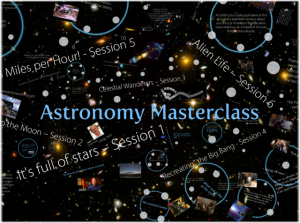From Earth to Moon
Lesson idea. This presentation looks at the story behind the American moon missions of the 1960's and the potential for a future mission to Mars. This is session 2 of the series of 6 entitled Astronomy Master Class.
Teaching approach. The race to the Moon was as much driven by politics as science, and this backdrop continues to influence space exploration and terrestrial research to this day. It was an amazing achievement to travel so far - guided by computers that were trivial set beside today's mobile phones. It is a story well worth telling to encourage engagement in science, scientific method(ta) as well as the understanding of the ethical(topic) context of this pursuit. (edit)
| Resource details | |
| Title | From Earth to Moon |
| Topic | |
| Teaching approach | |
| Learning Objectives |
|
| Format / structure | An 40 minute narrated screen cast which is part of the full, six hour 'Astronomy Master Class'. Also supplied as a Prezi and a Acrobat file should you wish to do the presentation yourself. The Astronomy Master Class overview describes how the resource was used. |
| Subject | |
| Age of students / grade | |
| Table of contents | |
| Additional Resources/material needed | |
| Useful information | |
| Related ORBIT Wiki Resources | |
| Other (e.g. time frame) | |
| Files and resources to view and download |
|
| Acknowledgement | |
| License | |
Teacher's Notes
Session 2- From the Earth to the Moon
The title of this session comes from the HBO series fronted by Tom Hanks made in the years following the Apollo 13 Movie. http://en.wikipedia.org/wiki/From_the_Earth_to_the_Moon_(TV_miniseries). The main aim here is to tell the story of how, why and when people last walked on the Moon.
- The moon has always been an important mysterious light in the nights sky
- Many myths and historical events are linked to the sky, moon and stars
- - Stonehenge http://en.wikipedia.org/wiki/Stonehenge
- - Egyptian pyramids laid out in the pattern of constellations (Orion) http://en.wikipedia.org/wiki/Orion_Correlation_Theory
- - Aristarchus – First heliocentric model – Eclipse calendars etc http://en.wikipedia.org/wiki/Aristarchus_of_Samos
- - The Middle Ages... not much else happened – in fact a lot was forgotten... pictures are some examples of the best lunar drawings of the era.
- Eugene Shoemaker, first theories of crater dynamics, first planetary geologist, involved in the proof that there were many asteroid craters on the moon – potential to be an astronaut until diagnosis with rare condition. Trained all Apollo astronauts in geology. http://en.wikipedia.org
/wiki/Eugene_Merle_Shoemaker#Astrogeology_and_Apollo - Video - JFK speech @ Rice University Texas, http://www.historyplace.com/speeches/jfk-space.htm
- JFK would die before his dream could be realised. America’s decision to go to the moon was as much political as it was scientific. Introduce cold war dynamics.
- Ranger 7 – First USA probe to take close up images of the moon. Impact mission – not really a “landing” – July 1964. Rangers 1-6 either broke down before reaching the moon or missed it entirely... http://en.wikipedia.org/wiki/Ranger_program
- Luna 9 – first soft landing on the moon – Russian Probe. Later Luna missions would land – collect and return soil samples. The Russians would focus on this technology whilst the Americans focused on manned missions. http://en.wikipedia.org/wiki/Luna_programme
- Gemini program. USA series of missions to test all technologies needed for a moon shot. Video - Following on from the mercury program with Alan Shepherd becoming the first American in space – Gemini was a great success paving the way for Apollo.
- Apollo 1 – Tragic loss of life during a “plugs out” test on the launch pad. Required a major redesign. I often demonstrate something burning in a pure oxygen environment to show the risks of this approach. http://en.wikipedia.org/wiki/Apollo_1
- Apollo 4, 5 and 6 were unmanned tests.
- Apollo 7 – Manned Earth orbit Test. http://en.wikipedia.org/wiki/Apollo_7
- Apollo 8 – Lunar Manned Free Return Test, Earthrise Picture taken http://en.wikipedia.org/wiki/Apollo_8
- Apollo 9 – Test on lunar Lander in Earth Orbit. http://en.wikipedia.org/wiki/Apollo_9
- Apollo 10 – Test on full system in Lunar Orbit
- - Got to within 16km of the surface of the moon. http://en.wikipedia.org/wiki/Apollo_10
- Apollo 11 – Landed Video – Apollo 11 landing on the Moon
- Apollo 12 – Landed next to Surveyor 3 (previous unmanned probe) to allow collection of parts of the lander for analysis. http://en.wikipedia.org/wiki/Apollo_12
- Apollo 13 – A successful Failure – Used Apollo 8’s pre-tested free return trajectory. Video – Apollo 13 movie trailer http://en.wikipedia.org/wiki/Apollo_13
- Apollo 14
- - Played golf on the moon using a makeshift club
- - http://en.wikipedia.org/wiki/Apollo_14
- - US public starting to lose interest
- Apollo 15
- - Longer stay on the moon than before – Lunar rover used
- - http://en.wikipedia.org/wiki/Apollo_15
- Apollo 16 http://en.wikipedia.org/wiki/Apollo_16
- Apollo 17
- - First scientist on the moon (Schmitt)
- - First night launch
- - Last mission (USA had beaten the Russians and so little political will remained for huge costs.)
- - Schmitt last man on the moon.
- - 3D picture – works with red and Green Gels http://en.wikipedia.org/wiki/Apollo_17
- Video is of Apollo 17 leaving the surface. Had to be controlled remotely and with a 4 second time lag from Huston. Video – Apollo 17 leaving the Moon
- Moon Map – Green Triangles are Apollo landings
- - Reds and Yellows are unmanned probes.
- - Apollo near equator to aid take-off due to angular momentum.
- The Future – Potential for mars? Eden project... Mars 500 program. Technical challenges etc. Video – Barak Obama Cancels a return to the Moon
End of session 2
Useful cloudy weather applications
- ESA Astronaut tests - http://www.esa.int/esaMI/Astronaut_Selection/SEMJOSRHKHF_0.html
- Build a Model Moon Base

